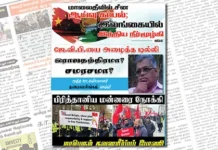Now the central Government working in the process of ending or dealing with refugee crisis in the Northern part of this vast sub continent but failing to address the huge appeal by its own sons and daughters. Yes, the people we pose here are indeed de facto Indians but coloured as Sri Lankans because of their intermittent stay of two or three generations. Refugee camps of Tamil Nadu are known to everyone but the Indian Origin Tamil refugees happened to be confined there is untold story. First part we need to perceive the presence of these Indian origins in the refugee camps of Tamil Nadu, then we discuss the durable solution collectively along with Native Sri Lankan Tamil refugees.
Brief story
In the beginning of 19th Century, the slavery system was said to be abolished in the British Kingdom. That eventually caused its siblings semi-slavery take their cart. So the people from the poor colony states were taken on the promise of job abroad mainly to Burma, Malaya, Ceylon and many other parts of the then British controlled land mass. Likewise the people from southern India mostly Tamil speaking, migrated to Sri Lanka (Ceylon), for working in the Tea estate areas in the southern part of Sri Lanka. This went successfully for the commercial interest of the employers.
So the cheap labour was encouraged through the “kangani system”, “thundu system” and etc led to large scale migration. In due course, families were also happened to settle there and these Indian Origin Tamils (IOTs) became a community in Sri Lanka called as Plantation Tamils or Hill Country Tamils or Up Country Tamils. Now the time comes for the Sri Lankan nationalism to wake up in 1948. Sri Lanka was given Independence that in turn nailed death knell to the national status of these Indian origin Tamils. That was done through Ceylon Citizenship Act,1948, disenfranchised 9,75,000 Indian Origin Tamils and became stateless people, who were given their blood and sweat for two centuries in the tea estates of the island. Even though in principle accepted the repatriation of willing people in discussion with Kotelawala, Jawarhal Nehru rejected the proposal of Sri Lanka to take back all of them to India.
Nehru said all those went to Burma, Malaya were accommodated there, and why not these people would be given Sri Lankan status. But unfortunate back foot in the north by Chinese aggression in 1962, later the demise of Nehru caused twin blows in the External Policies of India.
The uncertain rivalry in the Northern borders influenced the India to heed Sri Lanka. During Lal bahadur shastri as Prime minister, Srimavo – Shastri Pact was signed in 1964. Both countries decided to divide the people in 7:4 ratio and the repatriation of these Indian Origin Tamils began in 1965.
 Later when Indira Gandhi came to chair, Gandhi – Bhanadaranaike Pact 1974 concluded to divide those people left out of earlier pact in 1:1 ratio. The combined reading will be, out of 9,75,000 IOTs, 6,00,000 IOTs with their natural increase should be repatriated to India and Sri Lanka was agreed to provide citizenship for the rest 3,75,000 IOTs with their natural increase. This heavy human trade! Deal was not only suffered due to challenges in logistics but also short of opinion of the people upon whom these pacts were drawn.
Later when Indira Gandhi came to chair, Gandhi – Bhanadaranaike Pact 1974 concluded to divide those people left out of earlier pact in 1:1 ratio. The combined reading will be, out of 9,75,000 IOTs, 6,00,000 IOTs with their natural increase should be repatriated to India and Sri Lanka was agreed to provide citizenship for the rest 3,75,000 IOTs with their natural increase. This heavy human trade! Deal was not only suffered due to challenges in logistics but also short of opinion of the people upon whom these pacts were drawn.
Several of them wanted to stay in Sri lanka but rejected by the Sri Lankan Government on a whim. After completing the registration with Assistant High Commission, Kandy, these repatriates were taken through Thalaimannar port to Rameswaram Mandapam Camp by SS Ramunjam ship. Later they were allotted residence in many parts of Tamil Nadu, Karnataka and Andra Pradesh based on their choice of work and skills. But these happenings got its end when Sinhala fascistic goons attacked Tamils as a whole in Sri Lanka led to Black July Massacre shocked the sub continent as well as the globe. Several thousand Tamils killed and the famous Jaffna Library was burnt down caused the native Sri Lankan Tamils to run for life towards Indian shores.
India, due to public pressure from Tamil Nadu extended support for them and asylum seekers were received on a humanitarian view. But this posed a great challenge for the Indian officials to recognise and differentiate between the repatriates, those are Indian Origin Tamils coming from Sri Lanka and the refugees, those are native Sri Lankan Tamils taking asylum due to the ethnic persecution. So Indian authorities unilaterally stopped the repatriation process and started to keep all people coming from Sri Lanka in the Refugee Camps.
When they are suspending this repatriation in October,1984, only 4,61,631 IOTs [i]were repatriated, in contrast India was obliged to provide citizenship to 6,00,000 IOTs with their natural increase with respect to 1960s population. Thus nearly 1,40,000 IOTs with their natural increase were missed out from the repatriation. Some of these people were left there itself in Sri Lanka and considerable portion of them travelled on their own, mixed with Native Sri Lankan Tamils, living in the refugee camps of Tamil Nadu.
Refugee Camps in Tamil Nadu
There are nearly 60,000 refugees in Tamil Nadu residing at 108 camps spread across the state. But these population is not only those native Sri Lankan refugee but also Indian origin Tamils left in the incomplete repatriation are forming significant component of these population. For example in Namakkal District there are three refugee camps. There itself 594 families are Indian Origin whose forefathers migrated from Tamil Nadu during British era for working in the Tea estates of Sri Lanka. Likewise Kottapattu Camp in Trichirappalli, Kulithalai Refugee Camp, Bhavanisagar refugee camp in Erode and many other camps has substantial population of these Indian Origin Tamils.
 Mr. Vinothan, a social worker, he himself a Indian Origin Tamil tagged as Refugee, explaining the crisis “ we could not relate us with Sri Lanka, since we were beaten there because we went from India as well as Tamil speaking. But our own mother country tagging us as refugee and asking us to go back. We don’t have anything or anybody there. We need a dignified life by conferring Indian citizenship.” Since they were labourers they lived in Tea estate line houses and worked for sustenance, they could not have much land holding or any other property.
Mr. Vinothan, a social worker, he himself a Indian Origin Tamil tagged as Refugee, explaining the crisis “ we could not relate us with Sri Lanka, since we were beaten there because we went from India as well as Tamil speaking. But our own mother country tagging us as refugee and asking us to go back. We don’t have anything or anybody there. We need a dignified life by conferring Indian citizenship.” Since they were labourers they lived in Tea estate line houses and worked for sustenance, they could not have much land holding or any other property.
The case of Mr.T.Ganesan, a 67 year old resident of Irumboothypatti refugee camp, Karur is even worse. He was given Indian Citizenship in 1982 based on the Indo-Ceylon Accords but could not come here, since the Indian authorities suspended the repatriation due the ethnic violence. He had to run for life with his family in the war torn country till 1990 and by boat he was able to reach India on his own. But Indian authorities blanketly registered him as refugee and confined him in the refugee camp for 31 years so far. An Indian citizen living as Refugee in his own country is a flagrant violation of Indian Constitution. Likewise many people who are eligible to be accommodated with India are unnecessarily put to languish in refugee camps.
Mr.Thiyagavijayan, a resident of Kottapattu refugee Camp in Trichirappalli says “ we came to India in 1984 in the SS Ramanujam Ship as a repatriate. I have the copy of the ticket with which we travelled from Sri Lanka. We gave our documents with authorities on our arrival, they promised to confer Indian citizenship.
No action taken so far. Many times we had represented the authorities that we came through repatriation but they say we are a refugee. We are Hill country Tamils in Sri Lanka migrated several years before from India.” These people were not noticed of their concerns and voices because they came here during the time when ethnic violence was on high in Sri Lanka. The arrival of Native Sri Lankan Tamils out of sufferings silenced these people to wait for their turn that never came. The Rajiv Gandhi assassination totally changed the concerns for these innocent people by applying terrorist stigma over all of them came from Sri Lanka.
Durable solution must be doable solution
The present situation is these people lived for more than 30 years in India under many restrictions and stigmas. Now, even majority of Native Sri Lankan Tamils also in want for Indian Citizenship sending representations. Native Sri Lankan Tamils and Indian Origin Tamils, all those in refugee identity in India, are termed legally as “illegal migrant” as per Indian Citizenship Act,1955. Every route to acquire Indian Citizenship through birth, marriage etc, as they are “illegal migrants”, falling under that legal cavity. Now the time has come to decide what could be the solution for these people. The third country settlement was turned down and now extinguished.
So, only two sides for a coin. Embraced and stay in India or go back to Sri Lanka. There are for and against views for both of these solutions. Principle of non refoulement was impliedly recognised by the Madras High Court in 1992 when Indian authorities forcefully sending back Sri Lankan refugees aftermath of Rajiv Gandhi Assassination. In Nedumaran and Ors Vs Union of India and Ors, the High court said sending them back to Sri Lanka without their consent is illegal and ordered to stop those forceful journey.
 So, unless and until these people decide to go back, India will keep them in camps. But keeping them under surveillance and restricting their liberty over a long period, even generation after generation is a transgression of natural justice. Adding fuel to the fire, those who were facing the charges of Genocide in Sri Lanka, again now on the chair. It will certainly threaten the minds of refugees and resist them to go back. It is evident from the data, only 17,718 Tamil refugees went back to Sri Lanka in 2002-2020, but during 1983 -2001 there were 1,99,469 Tamil refugees went back to Sri Lanka.[ii] This shows the declining trend and lack of will among Tamil refugees to return Sri Lanka. The present financial crisis is apparent and will again impact further decline in the repatriation trend.
So, unless and until these people decide to go back, India will keep them in camps. But keeping them under surveillance and restricting their liberty over a long period, even generation after generation is a transgression of natural justice. Adding fuel to the fire, those who were facing the charges of Genocide in Sri Lanka, again now on the chair. It will certainly threaten the minds of refugees and resist them to go back. It is evident from the data, only 17,718 Tamil refugees went back to Sri Lanka in 2002-2020, but during 1983 -2001 there were 1,99,469 Tamil refugees went back to Sri Lanka.[ii] This shows the declining trend and lack of will among Tamil refugees to return Sri Lanka. The present financial crisis is apparent and will again impact further decline in the repatriation trend.
Refugee citizens
So I personally suggest the conferment of Indian citizenship for all those residing in refugee camps would be the best solution. The way for such deliberate step was already moulded in Ulaganathan and Ors Vs Union of India, where the Madurai Bench of Madras high court said, even though Tamil refugees are indeed comes under illegal migrant definition, a sovereign country can look beyond that restriction and confer Indian citizenship.
But unfortunately that decision was not bearing the fruits it intended. Also the Central Government through CAA and some executive actions prepared to grant citizenship to the illegal migrants belong to Hindu, Parsi, Christian, Sikh, Jain and Buddhist religions came from Pakistan, Afganistan and Bangladesh, who were suffered religious persecution in those countries. They would get Indian citizenship if they are living for at least 5 years and they should have entered India before the cut off date 31st December,2014. But these Tamil refugees from Sri Lanka were brutally attacked, persecuted based on ethnicity and their presence was nearly 30 years will qualify them more than those refugees came from the three countries.
Especially, the Indian Origin Tamils in the refugee camps has more prominent right to Indian Citizenship based on the Accords where India’s commitment was not fulfilled. Even though 1,40,000 IOTs with their natural increase was not repatriated as per accords, Sri Lanka gave their Citizenship in 2003 to all those who were present in Sri Lanka irrespective of their registration with the Indian High Commission. Some 80,000 Indians were also surrendered their Indian Passport and got Sri Lankan Citizenship.
So it would be appropriate and not a wrong if Indian Government issue Indian citizenship to Indian origin Tamil refugees and also to Native Sri Lankan Tamils on humanitarian basis on the plank of Indo-Ceylon Pacts 1964 and 1974. In Assam the indigenous tribes voicing against these CAA because the major portion of those refugees are Bengalis which will endanger their demography. But here in Tamil Nadu, the local population ready to welcome these Tamil refugees to get assimilated, since they are one linguistic cultural people. A Tamil speaking people living as refugee in Tamil state (Tamil Nadu) is heart itching and Indian citizenship for those Tamil refugees of Indian Origin and Sri Lankan origin is the needful solution for their dignified life.

Romeo Roy Alfred.
Advocate, Madras High Court
[i] Department of Rehabilitation, Information Handbook under Right To Information Act 2005
[ii] Right To Information – Reply from Department of Rehabilitation dated 02.11.2020





